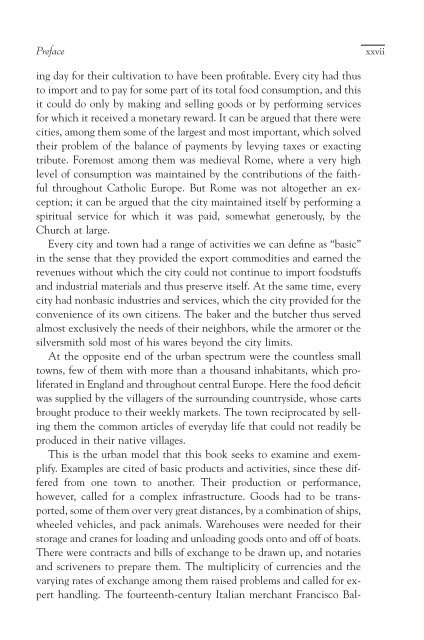CITIES AND TOWN The medieval city.pdf
CITIES AND TOWN The medieval city.pdf
CITIES AND TOWN The medieval city.pdf
Create successful ePaper yourself
Turn your PDF publications into a flip-book with our unique Google optimized e-Paper software.
Preface xxvii<br />
ing day for their cultivation to have been profitable. Every <strong>city</strong> had thus<br />
to import and to pay for some part of its total food consumption, and this<br />
it could do only by making and selling goods or by performing services<br />
for which it received a monetary reward. It can be argued that there were<br />
cities, among them some of the largest and most important, which solved<br />
their problem of the balance of payments by levying taxes or exacting<br />
tribute. Foremost among them was <strong>medieval</strong> Rome, where a very high<br />
level of consumption was maintained by the contributions of the faithful<br />
throughout Catholic Europe. But Rome was not altogether an exception;<br />
it can be argued that the <strong>city</strong> maintained itself by performing a<br />
spiritual service for which it was paid, somewhat generously, by the<br />
Church at large.<br />
Every <strong>city</strong> and town had a range of activities we can define as “basic”<br />
in the sense that they provided the export commodities and earned the<br />
revenues without which the <strong>city</strong> could not continue to import foodstuffs<br />
and industrial materials and thus preserve itself. At the same time, every<br />
<strong>city</strong> had nonbasic industries and services, which the <strong>city</strong> provided for the<br />
convenience of its own citizens. <strong>The</strong> baker and the butcher thus served<br />
almost exclusively the needs of their neighbors, while the armorer or the<br />
silversmith sold most of his wares beyond the <strong>city</strong> limits.<br />
At the opposite end of the urban spectrum were the countless small<br />
towns, few of them with more than a thousand inhabitants, which proliferated<br />
in England and throughout central Europe. Here the food deficit<br />
was supplied by the villagers of the surrounding countryside, whose carts<br />
brought produce to their weekly markets. <strong>The</strong> town reciprocated by selling<br />
them the common articles of everyday life that could not readily be<br />
produced in their native villages.<br />
This is the urban model that this book seeks to examine and exemplify.<br />
Examples are cited of basic products and activities, since these differed<br />
from one town to another. <strong>The</strong>ir production or performance,<br />
however, called for a complex infrastructure. Goods had to be transported,<br />
some of them over very great distances, by a combination of ships,<br />
wheeled vehicles, and pack animals. Warehouses were needed for their<br />
storage and cranes for loading and unloading goods onto and off of boats.<br />
<strong>The</strong>re were contracts and bills of exchange to be drawn up, and notaries<br />
and scriveners to prepare them. <strong>The</strong> multipli<strong>city</strong> of currencies and the<br />
varying rates of exchange among them raised problems and called for expert<br />
handling. <strong>The</strong> fourteenth-century Italian merchant Francisco Bal-
















